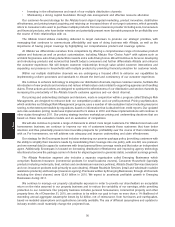Allstate 2011 Annual Report Download - page 120
Download and view the complete annual report
Please find page 120 of the 2011 Allstate annual report below. You can navigate through the pages in the report by either clicking on the pages listed below, or by using the keyword search tool below to find specific information within the annual report.
Comparatively, the average annual impact of catastrophes on the homeowners loss ratio for the years 1992 through
2010 is shown in the following table.
Average annual impact of catastrophes on the
Average annual impact of homeowners loss ratio excluding losses from
catastrophes on the hurricanes Andrew and Iniki, and losses from
homeowners loss ratio California earthquakes
Florida 97.9 47.5
Other hurricane exposure states 28.2 28.0
Total hurricane exposure states 33.8 29.6
All other 23.9 19.2
Total 29.2 24.8
Over time, we have limited our aggregate insurance exposure to catastrophe losses in certain regions of the country
that are subject to high levels of natural catastrophes. Limitations include our participation in various state facilities,
such as the CEA, which provides insurance for California earthquake losses; the FHCF, which provides reimbursements
to participating insurers for certain qualifying Florida hurricane losses; and other state facilities, such as wind pools.
However, the impact of these actions may be diminished by the growth in insured values, and the effect of state
insurance laws and regulations. In addition, in various states we are required to participate in assigned risk plans,
reinsurance facilities and joint underwriting associations that provide insurance coverage to individuals or entities that
otherwise are unable to purchase such coverage from private insurers. Because of our participation in these and other
state facilities such as wind pools, we may be exposed to losses that surpass the capitalization of these facilities and to
assessments from these facilities.
We continue to take actions to maintain an appropriate level of exposure to catastrophic events, including the
following:
• We have increased our utilization of wind storm pools. For example, in Texas we are ceding significant wind
exposure related to insured property located in wind pool eligible areas along the coast including the Galveston
Islands.
• We have ceased writing new homeowners business in California. We will continue to renew current
policyholders and have a renewal ratio of approximately 92% in California.
• Encompass Floridian Insurance Company and Encompass Floridian Indemnity Company ceased providing
property insurance in the State of Florida.
• We ceased offering renewals on certain homeowners insurance policies in New York in certain down-state
geographical locations. The level of non-renewals in New York is limited by state statute.
Hurricanes
We consider the greatest areas of potential catastrophe losses due to hurricanes generally to be major metropolitan
centers in counties along the eastern and gulf coasts of the United States. Usually, the average premium on a property
policy near these coasts is greater than in other areas. However, average premiums are not considered commensurate
with the inherent risk of loss. In addition and as explained in Note 13 of the consolidated financial statements, in various
states Allstate is subject to assessments from assigned risk plans, reinsurance facilities and joint underwriting
associations providing insurance for wind related property losses.
We have addressed our risk of hurricane loss by, among other actions, purchasing reinsurance for specific states
and on a countrywide basis for our personal lines property insurance in areas most exposed to hurricanes; limiting
personal homeowners new business writings in coastal areas in southern and eastern states; and not offering
continuing coverage on certain policies in coastal counties in certain states. We continue to seek appropriate returns
for the risks we write. This may require further actions, similar to those already taken, in geographies where we are not
getting appropriate returns. However, we may maintain or opportunistically increase our presence in areas where we
achieve adequate returns and do not materially increase our hurricane risk.
Earthquakes
Actions taken to reduce our exposure from earthquake coverage are substantially complete. These actions
included purchasing reinsurance on a countrywide basis and in the state of Kentucky; no longer offering new optional
earthquake coverage in most states; removing optional earthquake coverage upon renewal in most states; and entering
into arrangements in many states to make earthquake coverage available through other insurers for new and renewal
business.
40
MD&A
























